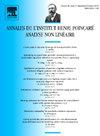L^1 -超临界Fokker-Planck方程的奇异性:定性分析
IF 2.2
1区 数学
Q1 MATHEMATICS, APPLIED
Annales De L Institut Henri Poincare-Analyse Non Lineaire
Pub Date : 2021-07-18
DOI:10.4171/aihpc/85
引用次数: 1
摘要
研究了一类具有超线性漂移的非线性Fokker-Planck方程在L^1 -超临界区具有有限临界质量。该方程具有正式的类瓦瑟斯坦梯度流结构,具有凸迁移率和自由能泛函,其最小值在临界质量以上具有奇异分量。奇点和集中也出现在进化问题中,它们的有限时间出现构成了一个主要的技术难题。本文的目的是对各向同性的情况进行全局实时定性分析,当时间趋于无穷大时,解收敛于自由能的唯一最小值。分析的关键步骤是在演化过程中适当地控制奇异剖面。我们的研究涵盖了玻色-爱因斯坦粒子的三维Kaniadakis- Quarati模型,从而提供了该模型超越爆炸和长时间渐近行为的连续的第一个严格结果。本文章由计算机程序翻译,如有差异,请以英文原文为准。
Singularities in $L^1$-supercritical Fokker–Planck equations: A qualitative analysis
A class of nonlinear Fokker-Planck equations with superlinear drift is investigated in the $L^1$-supercritical regime, which exhibits a finite critical mass. The equations have a formal Wasserstein-like gradient-flow structure with a convex mobility and a free energy functional whose minimising measure has a singular component if above the critical mass. Singularities and concentrations also arise in the evolutionary problem and their finite-time appearance constitutes a primary technical difficulty. This paper aims at a global-in-time qualitative analysis with main focus on the isotropic case, where solutions will be shown to converge to the unique minimiser of the free energy as time tends to infinity. A key step in the analysis consists in properly controlling the singularity profiles during the evolution. Our study covers the 3D Kaniadakis--Quarati model for Bose--Einstein particles, and thus provides a first rigorous result on the continuation beyond blow-up and long-time asymptotic behaviour for this model.
求助全文
通过发布文献求助,成功后即可免费获取论文全文。
去求助
来源期刊
CiteScore
4.10
自引率
5.30%
发文量
62
审稿时长
>12 weeks
期刊介绍:
The Nonlinear Analysis section of the Annales de l''Institut Henri Poincaré is an international journal created in 1983 which publishes original and high quality research articles. It concentrates on all domains concerned with nonlinear analysis, specially applicable to PDE, mechanics, physics, economy, without overlooking the numerical aspects.

 求助内容:
求助内容: 应助结果提醒方式:
应助结果提醒方式:


